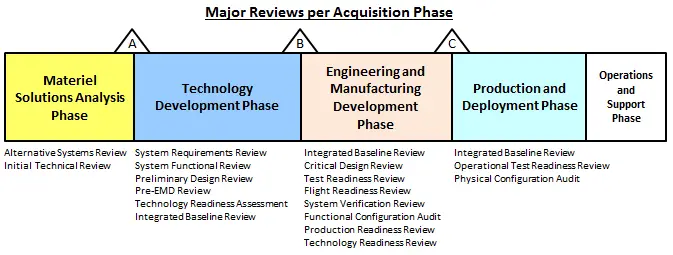An Alternative Systems Review (ASR) is a technical review that assesses the preliminary materiel solutions that have been developed during the Materiel Solution Analysis (MSA) Phase. The review ensures that one or more proposed materiel solution(s) have the best potential to be cost-effective, affordable, operationally effective, and suitable, and can be developed to provide a timely solution at an acceptable level of risk to satisfy the capabilities listed in an Initial Capabilities Document (ICD). The ASR helps the Program Manager and Systems Engineer ensure that further engineering and technical analysis needed to draft the system performance specification is consistent with customer needs.
Checklist: ASR Risk Assessment
Checklist: Alternative System Review Checklist – Jan 12
A successful ASR is predicated on the review team’s determination that the operational capabilities, proposed solution(s), available technologies, and program resources (funding, schedule, staffing, infrastructure, and processes) form a satisfactory basis for proceeding into the Technology Maturation & Risk Reduction (TMMR) Phase. An ASR should provide information to the Milestone A review before proceeding into the TD Phase.
Completion of the ASR should provide the following: [1]
- An agreement on the proposed material solution(s) (including the corresponding product support concept) to take forward into the milestone decision and subsequent Technology Development phase.
- Hardware and software architectural constraints/drivers to address all Key Performance Parameters (KPPs)
- An assessment of the full system software concept to include a conceptual definition of the complete deliverable/non-deliverable software, scope, and risk.
- A comprehensive rationale for the proposed materiel solution(s), based upon the Analysis of Alternatives (AoA) that evaluated relative cost, schedule, performance (hardware, human, software), and technology risks.
- A comprehensive assessment of the relative risks associated with including Commercial off-the-Shelf (COTS)items in the program, with emphasis on host platform environmental design, diagnostic information integration, and maintenance concept compatibility.
- A comprehensive risk assessment for the Technology Development (TD) Phase.
- Results of Trade Studies/technical demonstrations for concept risk reduction.
- Joint requirements for the purposes of commonality, compatibility, interoperability, and integration.
- Refined thresholds and objectives initially stated as broad measures of effectiveness and suitability (e.g., Key Performance Parameters (KPP) / Key System Attributes (KSA)).
- Completed, comprehensive planning for the TD phase (hardware, software, and human systems), including critical components to be developed, prototyped, and demonstrated their cost, and critical path drivers. This planning could include an Integrated Master Plan (IMP) and Integrated Master Schedule (IMS).
- Initial planning for the Engineering and Manufacturing Development phase.
- A draft System Requirements Document (SRD) if one does not already exist. (This is a high-level engineering document that represents the customer/user capability needs as system requirements.) This systems requirement document should include a system-level description of all software elements required by the preferred system concept.
Alternative Systems Review (ASR) Completion
The Technical Review Chair determines when the review is complete. ASR technical outputs should include, but not be limited to, the following products, including supporting rationale and trade study results: [1]
- Refined description of the preferred materiel solution to support further development
- Informed advice to the user-developed draft Capability Development Document (CDD) required at Milestone A
AcqTips:
- The ASR risk assessment checklist is designed as a technical review preparation tool and should be used as the primary guide for assessing risk during the review.
AcqLinks and References:
- [1] Defense Acquisition Guidebook (DAG)
- ASR Pre-Questionnaire
- Checklist: Alternative System Review Checklist – Jan 12
- Checklist: ASR Risk Assessment Checklist
- White Paper: Alternative Systems Review (ASR)
Updated: 7/19/2021
Rank: G1

